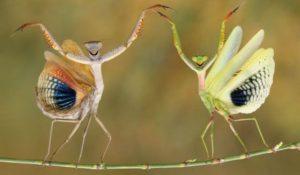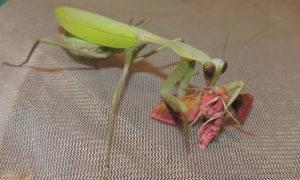Photo of the praying mantis and features of the nature of the insect
Everyone knows such insects as praying mantises. They are often found in nature. Fame brought them appearance and fearless disposition. They attack their prey with lightning speed. Collision with it is fatal for other insects.
Content
What does the praying mantis look like: photo
Description of the insect
Name: Mantis common or religious
Latin: Praying MantisClass: Insects - Insecta
Squad: Mantis - Mantodea
Family: Real praying mantis - Mantidae
 | Habitats: | garden |
 | Dangerous for: | carrots, potatoes, cats |
 | Means of destruction: | rohypnol, arduan, methanol, clenbuterol, morphine, sebazon, propafol. |
There are over 2000 varieties of insects.
The praying mantis has an impressive size. The females are larger than the males. The body length is about 6 cm. The largest variety reaches 15 cm. The body has an elongated shape. The head is triangular and movable.
The eyes are huge, bulging, faceted. A slight downward and straight direction provides a wider view than humans. Thanks to the flexible neck, the head quickly turns 360 degrees. The pest is able to quickly notice an object located behind.
The oral apparatus is well developed. One ear provides excellent hearing.
Individuals come with wings and without. The anterior wings of the first variety are narrower than the hind wings. The hindwings are membranous and fold like a fan. Usually, the wings of an insect frighten enemies.
The belly has a flattened soft shape. It is covered with numerous processes - cerci. They act as organs of smell.
Powerful spikes are located on the lower edge of the lower leg and thigh. The folding of these parts of the body contributes to the formation of a strong grasping device. Actions are similar to ordinary scissors.
Habitat influences coloration. Shades can be yellow, pinkish, green, brown-gray. This is the great ability to disguise.
Of the most common types, it is worth noting:
- ordinary - with a greenish or brown color. The main difference from relatives is the presence of a round black spot on the inside of the forelimbs;
- Chinese - lives in China. Its activity is observed at night;
- Indian flower - up to 4 cm in length. Habitat - India, Vietnam, Laos, Asian countries. It is distinguished by a more elongated body of a greenish or cream hue. There are white inclusions;
- orchid - an unusual and original look makes it the most attractive. Range: Malaysia and Thailand. Looks like an orchid flower;
- eastern heterochaete or thorn-eye - inhabitants of eastern Africa. It looks like a branch. It has special jagged triangular outgrowths-thorns.
Life cycle
| Mating timing | The mating season falls at the end of summer-beginning of autumn. |
| Search for partners | Males use their sense of smell when looking for females. |
| Masonry | The female lays eggs with the release of a special foamy liquid. The brown liquid solidifies and becomes a light capsule. It usually contains from 100 to 300 eggs. |
| Capsules | One female reproduces more than 1000 individuals, hanging capsules during the season. The capsule withstands temperatures of 20 degrees below zero. |
| Occurrence of offspring | With the advent of spring, hatching of larvae begins. They differ in mobility. The difference from adult praying mantises is the absence of wings. After the eighth molt, the larvae become adults. |
Mantis male: hard fate
Often males become victims of offspring. Eggs develop rapidly, and emerging females need protein. During mating or after it, the female eats the male. In some cases, the male may escape. Then he will save his life.
Habitat of praying mantises
Habitat - Malta, Sicily, Sardinia, Corsica. They were brought to the USA and Canada at the end of the 19th century. They live:
- France;
- Belgium;
- Southern Germany;
- Austria;
- Czech Republic;
- Slovakia;
- south of Poland;
- forest-steppes of Ukraine;
- Belarus;
- Latvia;
- Asia and Africa;
- North America.
Insect diet
Praying mantises are real predators. The largest representatives prey on frogs, birds, lizards. It takes 3 hours to eat. Prey is digested up to 7 days. Usually prey are flies, mosquitoes, moths, beetles, bees.
Protective coloring helps to hunt. Thanks to her, insects expect prey and go unnoticed. A large victim is being watched for a long time. Overtaking it, they jump and eat. The reaction is caused by objects in motion. Pests are particularly gluttonous. In the diet of a single meal, there are from 5 to 7 cockroaches. First, the predator consumes soft tissues, and then all other parts. Praying mantises can live in one place if there is enough food.
The value of praying mantises in nature
Praying mantises are real helpers in the fight against pests of various crops. In some Asian countries, they are kept at home to kill flies. They are real biological weapons. Sometimes they are shown at exhibitions as exotic animals.
Interesting Facts
Some interesting facts:
- praying mantis personified a symbol of stubbornness and greed in ancient China;
- the Greeks used them to determine the weather in the spring;
- females are larger than males and are unable to fly;
- eggs are not afraid of frost and pesticides;
- the praying mantis is absolutely safe for people;
- insects are able to attack a deadly poisonous spider - a black widow;
- do not eat dead insects;
- have a tendency to cannibalism.
Conclusion
Praying mantises bring great benefits to people. Meeting with them is terrible only for insects. Some species are listed in the Red Book and require careful treatment. The population is growing every year.
Previous

